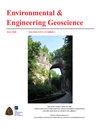Water and Sediment Supply Requirements for Post-Wildfire Debris Flows in the Western United States
IF 1
4区 工程技术
Q4 ENGINEERING, ENVIRONMENTAL
引用次数: 2
Abstract
This work explores two hypotheses related to runoff-related post-wildfire debris flows: 1) their initiation is limited by rainstorm intensity rather than cumulative rainfall depths and 2) they are not sediment supply limited. The first hypothesis suggests that it is common to generate more than enough rainfall to account for the volume of water in the debris flow, but to actually produce a debris flow, the water must be delivered with sufficient intensity. This is demonstrated by data from 44 debris flows from eight burned areas in California, Colorado, and Utah. Assuming a debris flow comprises 30 percent water and 70 percent solids, these events were generated during rainstorms that produced an average of 17 times as much water as necessary to develop a debris flow. Even accounting for infiltration, the rainstorms still generated an overabundance of water. Intensity dependence is also shown by numerous cases in which the exact timing of debris flows can be pinpointed and is contemporaneous with high-intensity bursts of rainfall. The hypothesis is also supported by rainfall intensity-duration thresholds where high-volume storms without high-intensity bursts do not generate debris flows. The second hypothesis of sediment-supply independence for the initiation of debris flows is supported by a significant increase in flow volume occurring directly after wildfire, compared to flows in unburned terrain. Also, repeated flows within short time intervals are only possible with an abundance of channel sediment, dry ravel, and bank failure material that can be mobilized. Field observations confirm these sediment sources, even directly after a debris-flow.美国西部野火后泥石流的水和沉积物供应要求
这项工作探讨了与野火后泥石流相关的两个假设:1)它们的开始受到暴雨强度而不是累积降雨深度的限制;2)它们不受沉积物供应的限制。第一个假设认为,通常会产生足够多的降雨来解释泥石流中的水量,但要真正产生泥石流,水必须以足够的强度输送。来自加利福尼亚州、科罗拉多州和犹他州八个被烧毁地区的44个泥石流的数据证明了这一点。假设泥石流由30%的水和70%的固体组成,这些事件是在暴风雨中产生的,暴风雨产生的水平均是形成泥石流所需水的17倍。即使考虑到渗透,暴雨仍然产生了过量的水。强度依赖性还表现在许多情况下,其中泥石流的确切时间可以确定,并且与高强度降雨同时发生。该假设也得到降雨强度-持续时间阈值的支持,即没有高强度爆发的大容量风暴不会产生泥石流。与未燃烧地形的流量相比,野火发生后直接发生的流量显著增加,这支持了泥石流形成与沉积物供应无关的第二个假设。此外,在短时间间隔内的重复流动只有在有丰富的河道沉积物、干漂移和可动员的河岸破坏物质的情况下才有可能发生。实地观察证实了这些沉积物的来源,甚至在泥石流之后也是如此。
本文章由计算机程序翻译,如有差异,请以英文原文为准。
求助全文
约1分钟内获得全文
求助全文
来源期刊

Environmental & Engineering Geoscience
地学-地球科学综合
CiteScore
2.10
自引率
0.00%
发文量
25
审稿时长
>12 weeks
期刊介绍:
The Environmental & Engineering Geoscience Journal publishes peer-reviewed manuscripts that address issues relating to the interaction of people with hydrologic and geologic systems. Theoretical and applied contributions are appropriate, and the primary criteria for acceptance are scientific and technical merit.
 求助内容:
求助内容: 应助结果提醒方式:
应助结果提醒方式:


